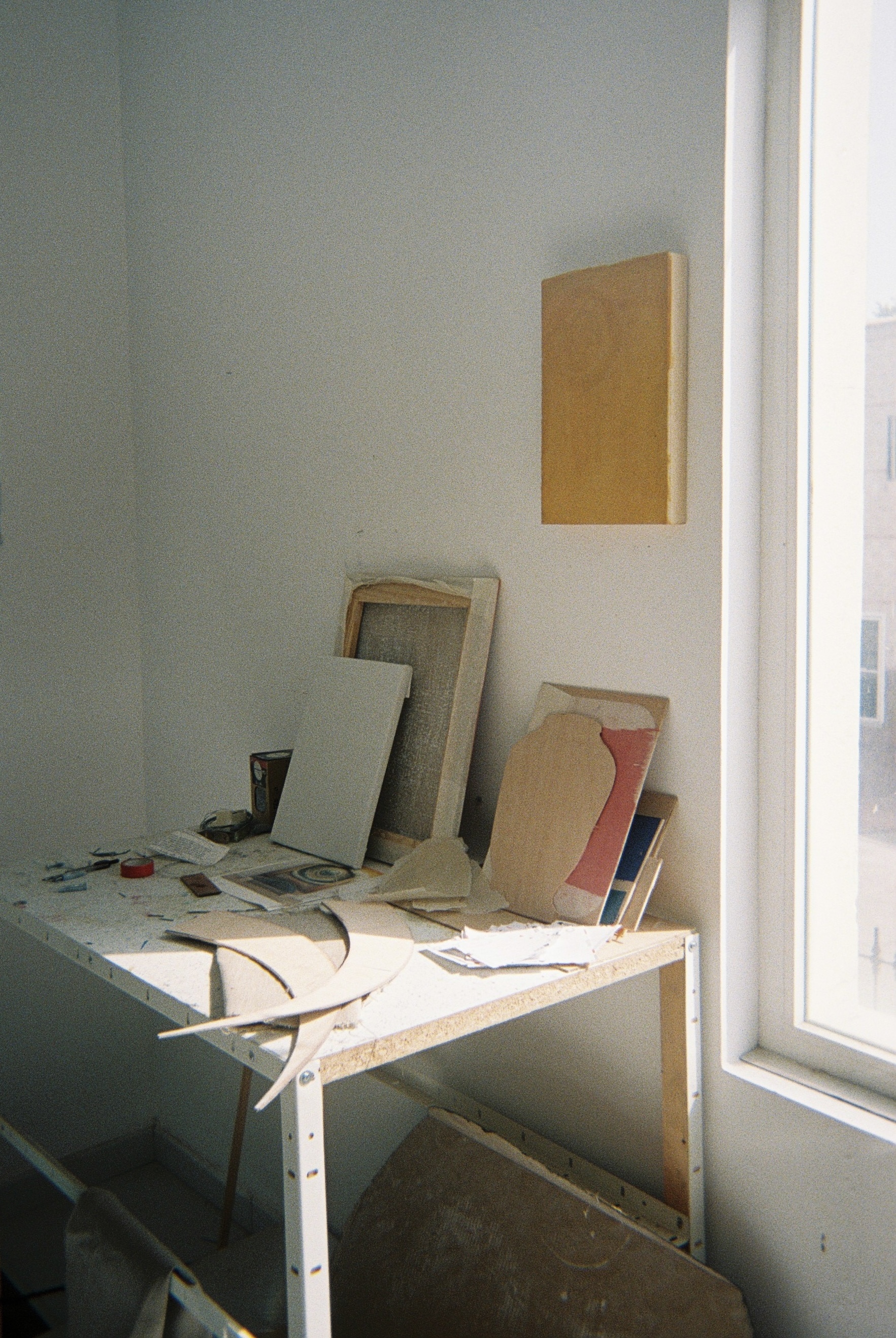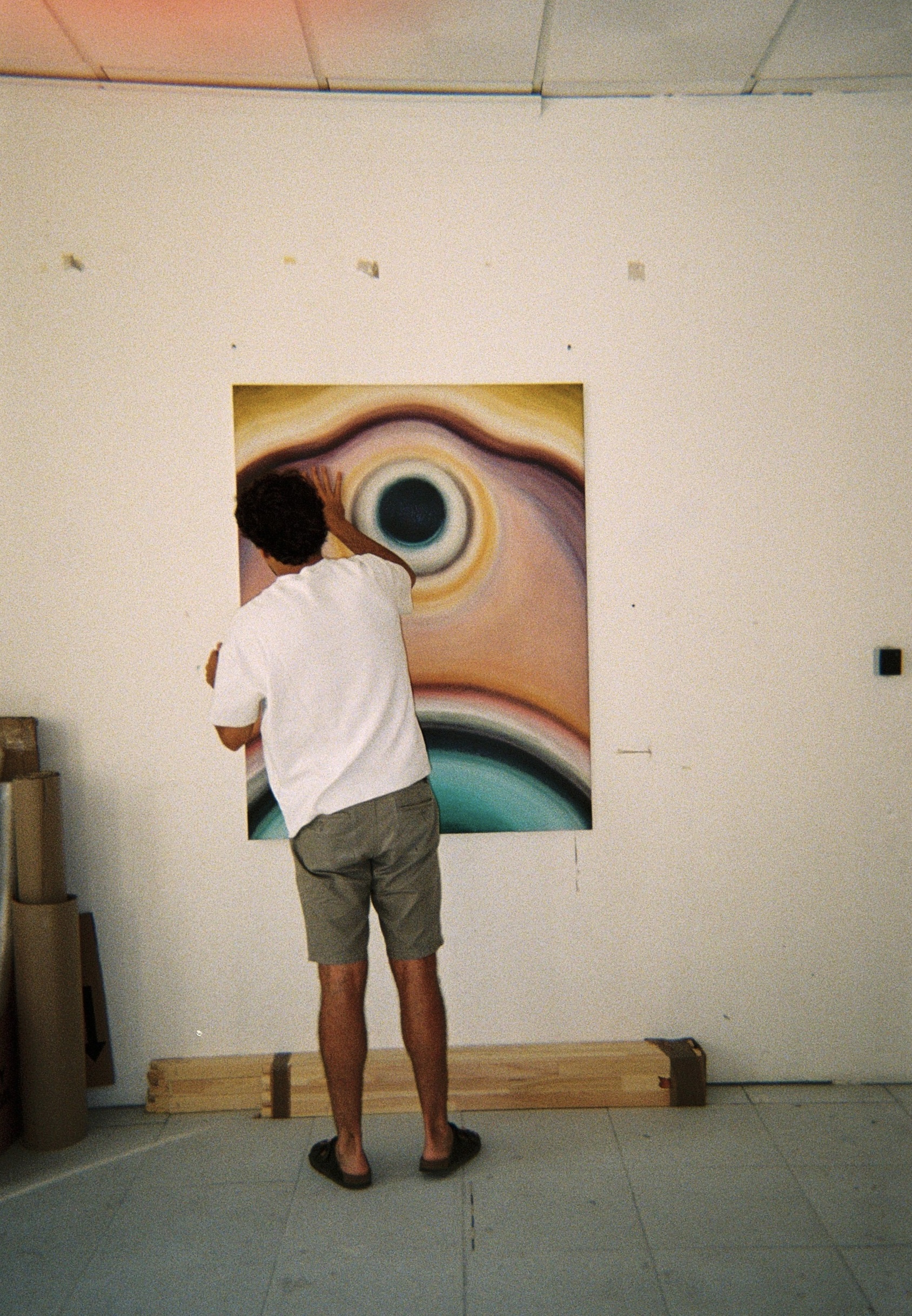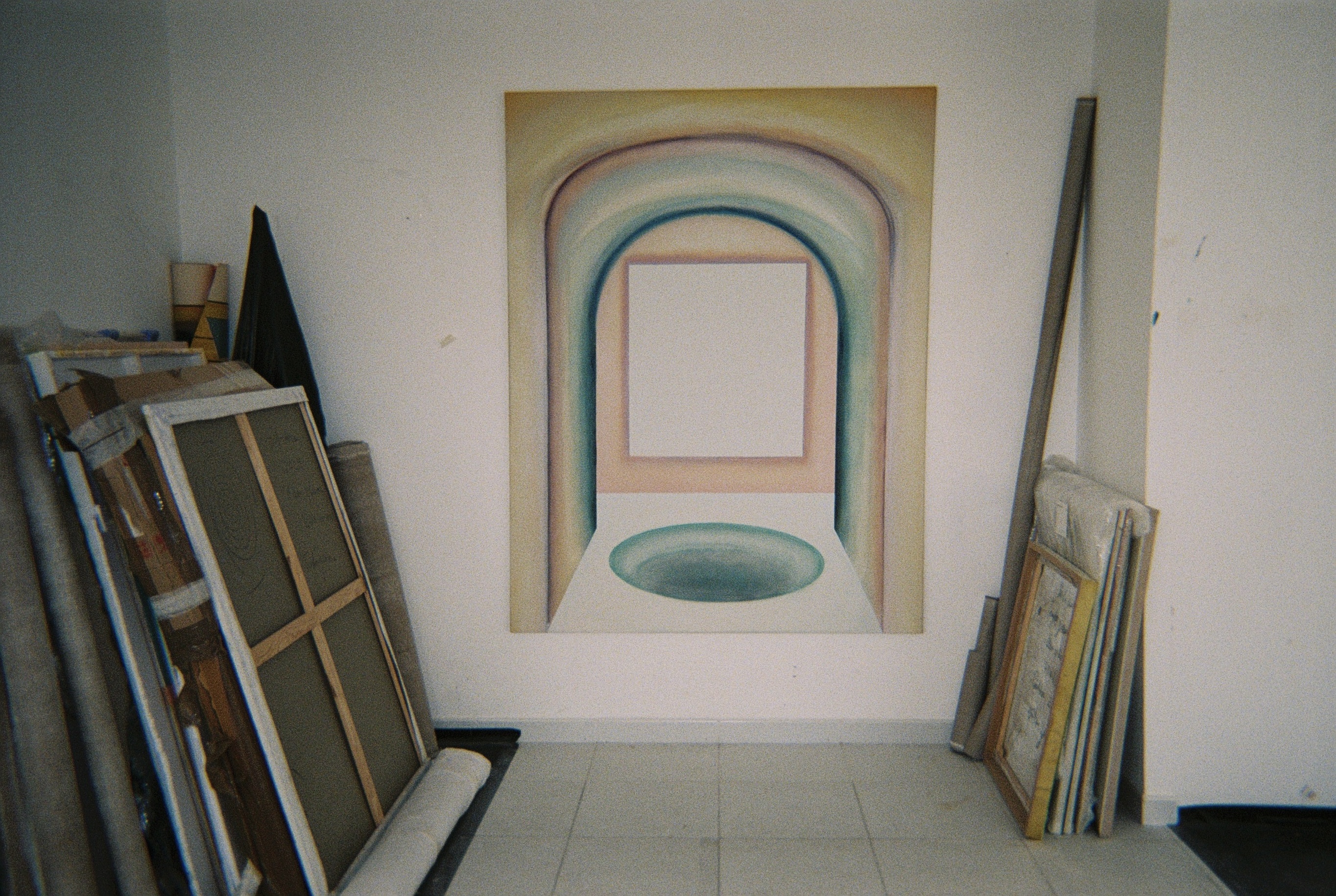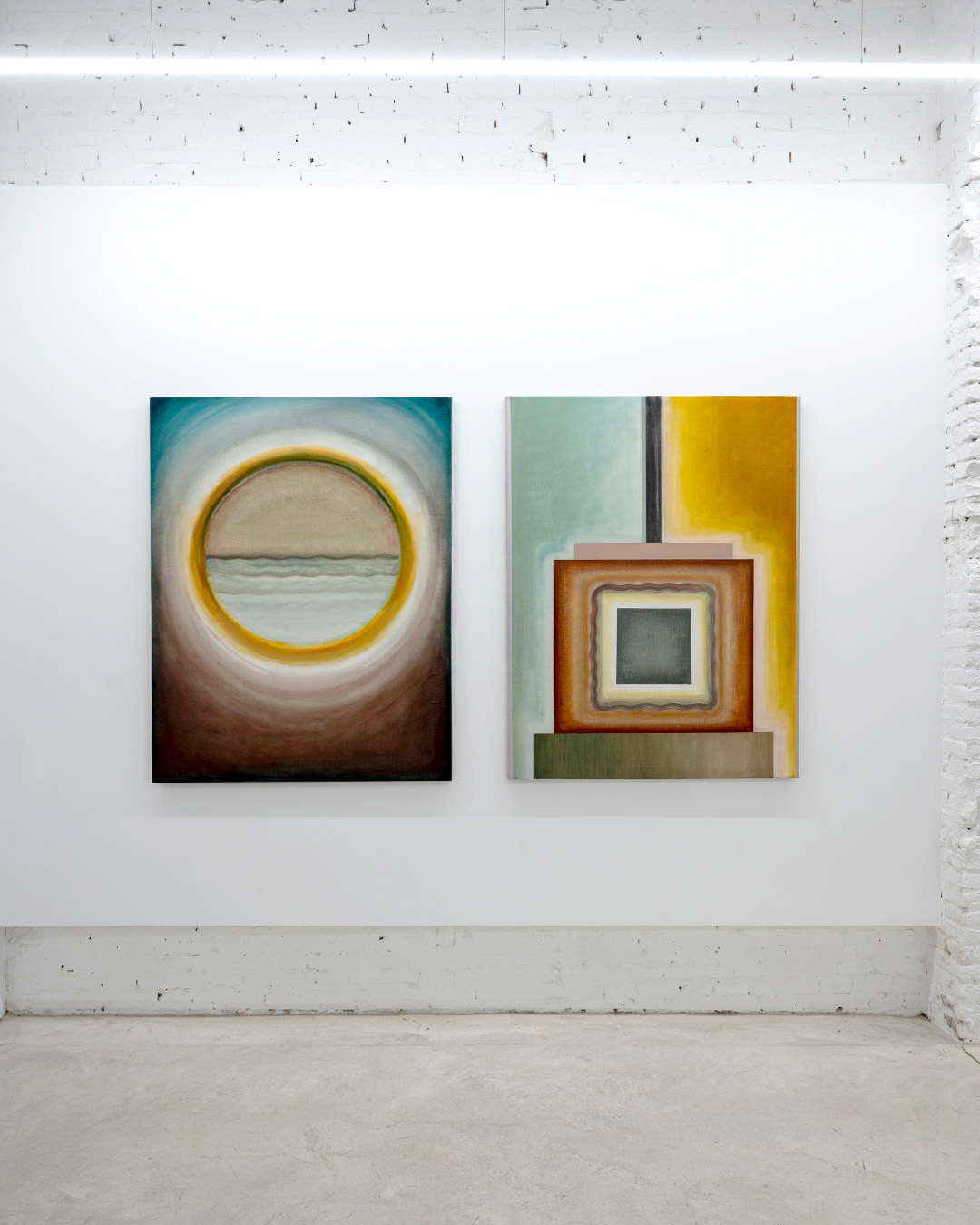I meet painter Víctor González at his studio on the outskirts of Jerez. Inside, the space is filled with paintings that feel like portals — not so much windows to the outside, but thresholds into a liquid, undulating, mental space. Víctor welcomes me among stacked canvases and others still in progress, annotated sketchbooks, and small sculptures that feel like marginal notes to the paintings.
Painting has something deeply sensual, he tells me. (And often, apparently, even beyond that...) His works, though geometric, appear diffuse, aquatic, perpetual — in their seemingly endless unfolding. He’s drawn to painting that reflects on itself, meta-painting: the inner space of the canvas as a living, alterable place that can contain both imaginary architecture and impulsive gestures. “I paint from the subconscious,” he says. “From a mental place where I pour in memories, impressions, landscapes…” We also discuss his residency at the Antonio Gala Foundation, his Erasmus in Italy, the situation of artists in Andalusia, his recent projects, and his dreams of collaborating someday with set designers or other kinds of artists.
After our conversation, as we drive along the roads surrounding his studio, I’m struck by how much the landscape resembles his work: sinuous, clear, warm, slightly unreal. His painting is, in a way, the trace of those displacements. There’s something in it of tactile memory — colors that are felt more than seen, shapes that repeat themselves like echoes. Their sensuality spring from their materiality, but also in the rhythm with which each piece reveals itself to the viewer — without forcing itself, without closing itself off.
You’ve mentioned that it was during your Erasmus in Palermo when you transitioned from figuration to the pictorial language that characterizes your work today. Could you describe how you arrived at your current, more geometric and abstract style?
Yes, my work used to be figurative. When I started painting, I used to rely on a reference image. I had an imaginary world I returned to constantly. At that stage, I worked with acrylic on paper, almost like watercolors, very impulsively. I would jump back and forth between observing and painting. It was like a direct transcription, practically without structure, very free.
But over time, those jumps between observing and painting became more spaced out. I began to realize that the most interesting moments — or the ones I enjoyed the most — happened precisely when I painted without looking at the image. I started building architectures or spaces from memory, drawing from less precise stimuli: a clipping, a feeling, a landscape, a meeting, an event… Something less representational, more evocative. That was the seed of the language I’m still exploring today.
You say you paint from the subconscious. How do you trigger those internal images and access your personal imaginary?
Before starting a piece, there’s a moment when I think about what kind of painting I want to make, what identity it will have or what I want to express through it. From that abstract idea or intention, I begin looking for a structure that allows me to understand it.
During that search, references to reality, memories, or notes appear — elements I’ve stored along the way. I usually begin with a clear idea of one or several elements I want to include in the composition. Some coordinates that echo that initial idea.
From there, the process becomes more intuitive. I respond to the composition itself to see where it leads me. That part already comes from a personal, acquired material that often operates from the subconscious. I think that’s the moment when my internal imagery really activates. When I start diving deep into it.
 This morning, while driving through the roads of Jerez, I felt a very clear connection with your painting — in the colors, in the shapes… Do you think something from the place where you grew up has made its way into your work?
This morning, while driving through the roads of Jerez, I felt a very clear connection with your painting — in the colors, in the shapes… Do you think something from the place where you grew up has made its way into your work?Yes, I believe so. Going back to the idea of the subconscious: in the end, the place you live in, what you see, the knowledge you acquire, even how you relate to others and how life affects you in general... All of that shapes your character. That, in essence, is your material, your clay, so to speak. One creates from that.
In my case, my work is very open to receiving all that. It's almost like opening a door to let all that information in and allowing it to flow through the painting.
I also think my painting generates possible structures or landscapes through pictorial language. These are constructions that aim more at evoking sensations than at depicting specific places, but they are inevitably steeped in my context. Everything is part of it: the natural landscape, the urban one, the structures around me… Even the design of everyday objects or certain canons that are very present in my daily life. All of that filters into what I paint.
You also mentioned that during your time in Italy, you encountered a less touristy, more unexpected side of the country. I wanted to ask whether you found a connection with Italian painting, and if that influenced your work in any way. I’m thinking of that architectural tradition, the play between the real and the imaginary, the trompe-l’œil...
Yes, definitely. In certain Italian painting, space is represented in a very rigid way, constructed through architecture and mathematics. I’m fascinated by that kind of painting — the idea of using those very recognizable visual codes and tools to generate improbable spaces.
Spaces that at first glance might seem plausible… but which, little by little, the viewer realizes cannot actually exist — pointing directly to painting as a convention. That’s why I was so interested in that Italian tradition. You can recognize a window, a door, the vanishing lines of a floor… But what happens within the painting takes you somewhere else, beyond representational logic.
At that time, I leaned more into geometry. I think my compositions were more closed, more hermetic. Although that’s still a line I’m interested in, now I approach it in a looser way. I like to explore the codes of Western painting, and within that lies geometry, of course, but also many other elements.
Over time, I’ve opened more drawers in that “cabinet” that is painting. In one, there’s still that geometrical research; in another, for example, is my interest in exploring more physical aspects of painting — fluidity, gesture, etc. Sometimes I try to create encounters between forms that suggest something between the symbolic, the natural, and the telluric. I’m interested in that connection with processes that occur in daily life. They may seem like simple things, but they can be loaded with symbolism to generate dialogues: the visible and the invisible, the rational and the symbolic.
In the end, I think all these paths converge in my process. It’s no longer just one thing or the other; sometimes, they all coexist.
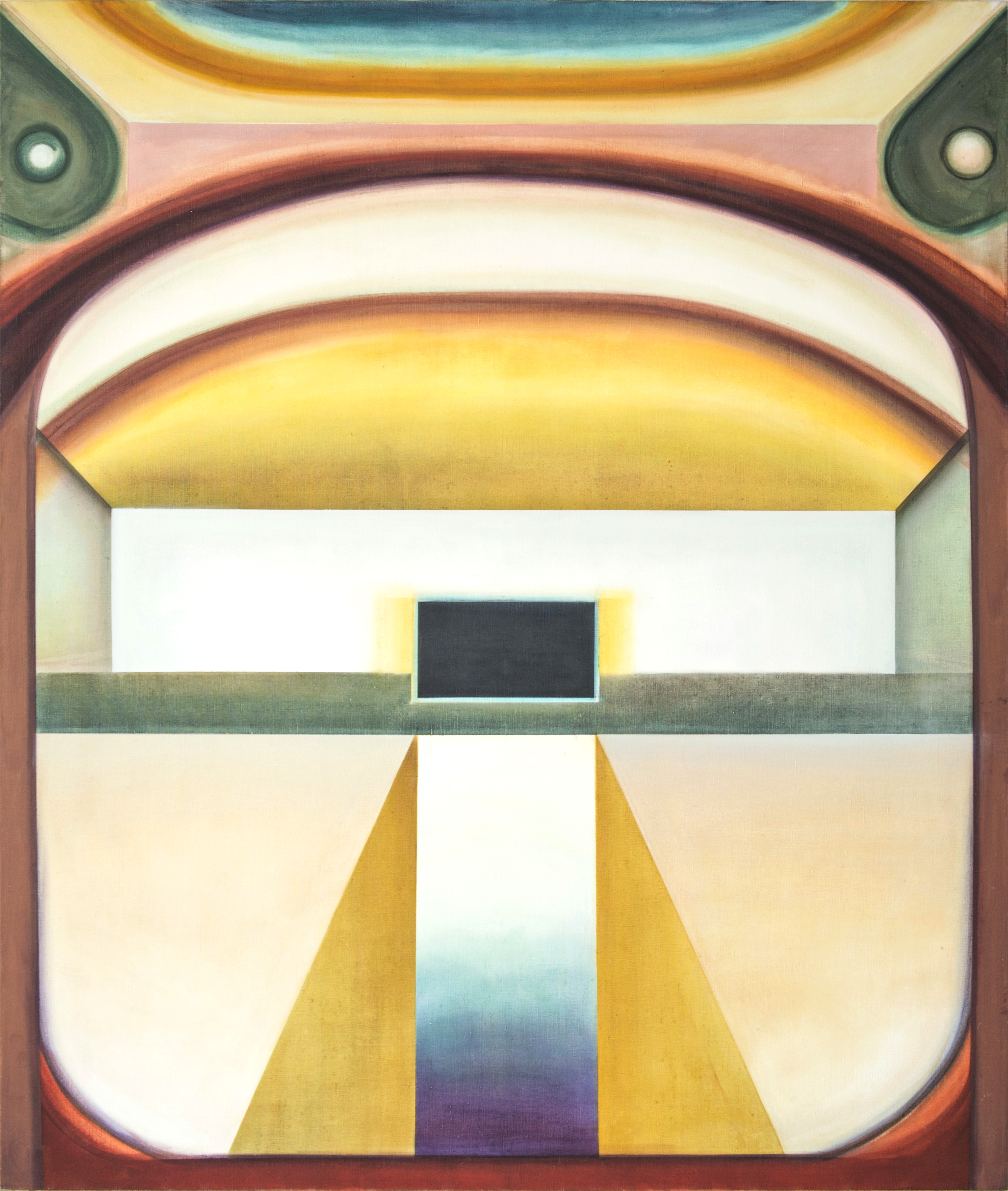
In several of your works — and in some of the references you mention — there is a very bodily presence, a kind of sensuality. Is that something you consciously explore in your painting?
For me, painting already has something deeply sensual, due to the physical encounter between materials during the process. In that visual language, there’s something tactile — about surface — that makes the viewer relate to the image from a different place. How this comes across has to do with temperament, with impulses toward color, speed, surface; I think it's something where the human is very present.
In my case, there are moments when the work generates spaces that evoke but don’t define. I’m interested in that limbo of meaning. I think, for example, of Brancusi — his altars don’t refer to any specific ritual but are full of aura — or Georgia O’Keeffe, who seems to speak of both landscapes and bodies with her gestures.
I think I move in that terrain: I offer coordinates, but never close off the meaning. The viewer receives these clues and reconstructs from there. Deep down, we all want to make sense of what we see, to connect the dots — but I believe there’s great value in simply observing, in allowing ourselves to be carried without needing to name everything.
That enveloping quality also comes through strongly in your use of color, which seems to carry a deep emotional or expressive weight in your work. Do you see it that way?
I don’t overthink it. Or rather, I don’t rationalize it. It’s something very intuitive. I don’t plan the colors or assign them any specific symbolism. Everything is decided on the fly. I apply color, see how it fits, how it relates to everything else; it’s a matter of trial and error. I think it has to do with my process — being conscious of where the work should go and remaining present throughout. There has to be some risk.
In another interview, you mentioned that music also influences your practice somehow — for example, Camarón or Kiko Veneno’s. Could you elaborate on this idea?
Yes, I listen to a lot of music while I work — Camarón, Kiko Veneno, and many others.
To answer this, I’m going to take some liberties… But I believe flamenco — good flamenco — has something very organic and natural in how it unfolds, something very complete. Behind many of those works lies a profound experience that has crystallized in both form and substance. Maybe what interests me is that rawness.
In Kiko’s case, for instance, I love how he relates to the creative process, how he accompanies it. He listens actively, accepts what emerges, and also seeks something. To me, that’s very similar to how I face painting — not as total control, but as a flow that sometimes surprises me, sometimes challenges me. My aspiration is for this way of doing things — this way of relating to what I do — to be genuine. To make sense to me. To feel true.
It’s complicated because you’re often not even fully aware of what you’re doing. I paint this way because I don’t know how to do it any other way. I find the beginning of a language, and from there I start working. While I’m in that process, I observe, I step back, I do and undo, but I’m in the mud, in the doing. I’m not thinking all the time about what sensation it will generate in others — I simply work from what I know, without seeing it as something extraordinary.
How was the process of moving from painting to collage, and combining both in your solo exhibition “Cabeza de Río” at Vangar Gallery?
That had a lot to do with how I organize myself while working. When I’m painting, I need a nearby space for play — something more free. At first, I called it my “logbook” because that’s how it worked: I’d fix ideas that came to me while painting or even outside the studio. I would staple clippings, drawings, notes… It was almost like a mental map.
When I compared that material to the painting next to it, I could see that it had qualities I wanted to explore further. So I began to organize those ideas and formalize certain elements, especially the more structural ones, like clippings or drawings. It was a natural transition.
What’s interesting is that collage allowed me to speak about painting from outside of painting. It gave me the chance to use other materials to address more formal topics and disrupt certain viewer expectations.
That makes me think that your work becomes a kind of meta-reflection on painting itself — do you agree?
I think so. I am constantly talking about painting. What interests me is reaffirming the medium as an end in itself. It is only through painting that certain sensations or encounters are generated. I am interested in that connection between the material and the viewer’s sensory experience.
I’m also fascinated by how the illusion we build through painting eventually reveals itself as just that: an illusion. That happens a lot in Baroque painting. There’s a game with the viewer — they’re offered an image that captivates and moves them, and suddenly the fiction is revealed. I think that doesn’t take away from the power of the painting — on the contrary. We believe it, we live it, we feel it. And that’s the powerful part: that something made only of paint can generate all that.
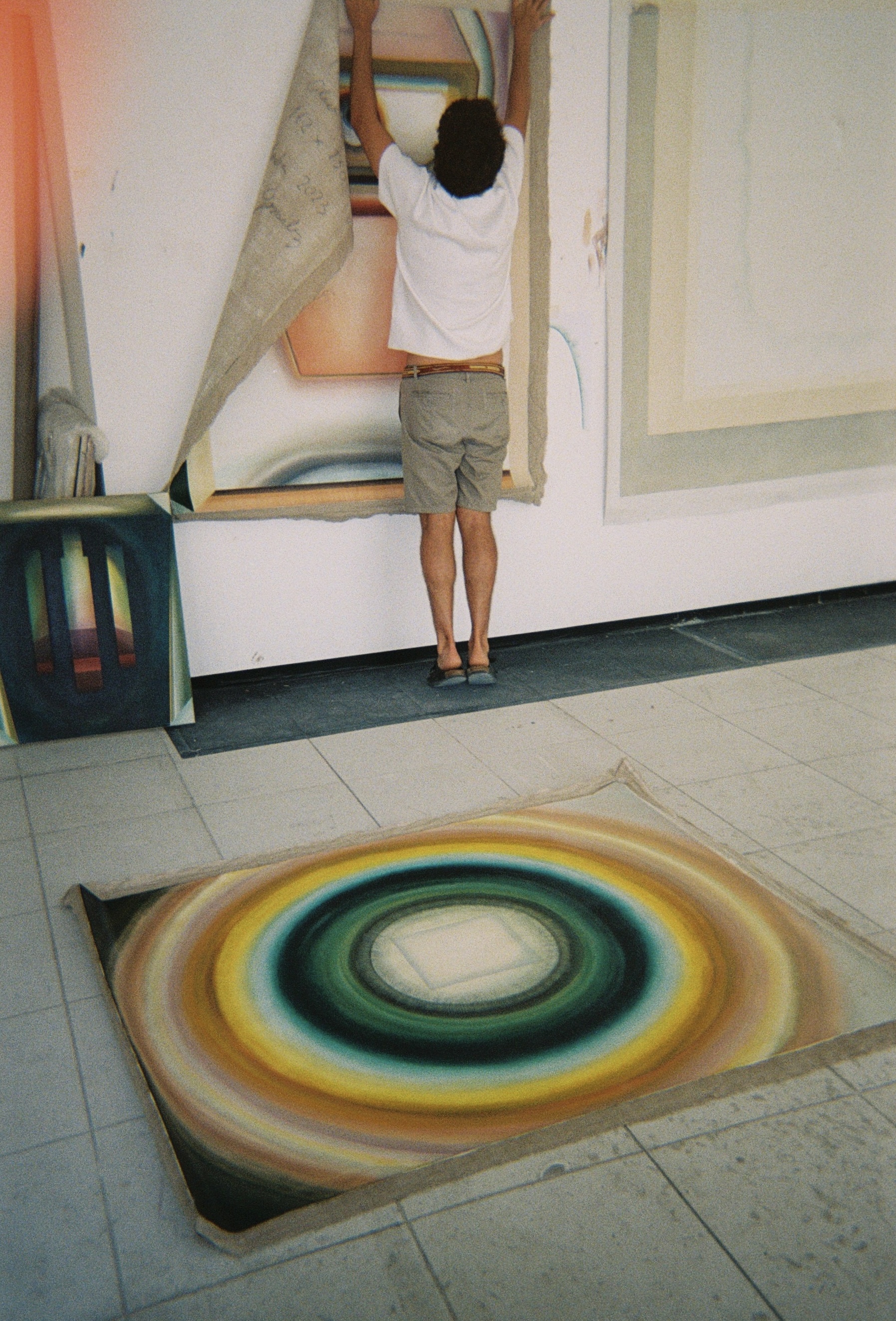
This brings in the question of format. How do you approach the size of your works, whether large or small?
It depends on the painting I want to make. It’s not something I worry too much about, unless there’s a very clear premise, either external or internal. But each painting responds to its own logic. For example, if I want to open a kind of “portal”, I can’t do it in 30 centimeters. I need a larger format for that.
So, normally, I first think about the painting’s coordinates, and then its size. I use large formats when I want to generate an immersive space, when there’s a psychological play with geometry or architecture. Smaller formats remain something more intimate.
All of this relates to something we have already discussed: your painting as a kind of scenography. Are you interested in that aspect?
Yes, I’m very interested. As a viewer, I love theater. I’m moved by the whole ritual that surrounds it: arriving, sitting down, waiting for the curtain to rise… And then something unexpected appears — a space that becomes believable, that tells a story.
I’m very intrigued by how that scenography is built, how it's reinterpreted in its narrative. I think it directly connects with my work in painting, especially in my interest in building spaces with their own internal logic.
I also think this profession demands constant searching. You need stimuli that help you grow, that move you. That’s where common ground opens up between painting and other personal interests: architecture, muralism... I’ve never done a mural in the street, but I would be interested in exploring that, or even collaborating on an architectural project — a façade, a house... I feel like all of that would feed my work and open up new creative paths.
I also wanted to ask about the title of your exhibition, Cabeza del Río, which I know comes from Lorca’s Take this Waltz. Is there a relationship between your work and literature or poetry?
Yes, absolutely. I believe that each artistic language has its own autonomy. That’s why I was looking for a title that would act almost like a trigger. Cabeza del Río is a very powerful image, and at the same time an impossible one. It has no clear form — it's almost a mechanism. You can't really visualize it, but precisely because of that, it activates a lot.
Also, I felt this image connected with how I approach my process. I work from a stream of thought, with bifurcations, with images that emerge along the way. I don’t build from a fixed idea, but follow a current with branches, turns, intensities. There’s something very fluid, very open and changing in my work. I think that title captured that feeling.
Looking at your work, I can’t help but see it as a kind of inner landscape — even a kind of self-portrait. Do you agree?
I don’t know if I’d call it a self-portrait — at least not in the classical sense of the word. There’s no direct representation of myself. But there is a very mental, very internal space. Some works feel like encounters, like fragments of thought.
There’s something very psychological in the whole process. Even if I don’t “see” myself in my paintings, I do recognize myself. I recognize myself in the working rhythms, in the decisions I make, in how I breathe with the painting. In that sense, yes, there may be something close to a psychological portrait. It’s an intimate dialogue between the material and me — between the form that’s emerging and my emotional state, my way of being in the world. It’s a reflection, even if not a literal one.
That becomes quite meaningful in today’s world, so saturated with digital images. What place do you think the painter occupies in this context? How do you relate to that visual excess?
Well… with resignation (laughs). It is part of the world we live in. There are good things, and others that are incredibly overwhelming. Images are everywhere — even where they shouldn’t be. Sometimes I feel like I need to escape, look the other way. I try not to be too exposed to social media. I am not at all interested in that kind of frenzied consumption.
I think it is precisely in that context that painting makes sense. Because it offers something else. It requires time, attention, concentration. It has a material dimension that is not exhausted in the image — it responds to environmental conditions: light, space, time… And I don’t think any screen can give you that.
To create — or to observe a piece of art — demands a different pace. I think it’s a rebellious act in itself. You position yourself against today’s attention economy. The act of painting — of dedicating yourself to this with honesty — is already a political stance of resistance.

That brings us to another topic we’ve often discussed: the lack of resources for artists and creators in Andalucía. What are your views on this situation?
I think there’s a clear lack of resources and poor management, although I also recognize that we live in a very competitive context. In the end, there are many people in this field and not everyone can receive support at the same time — someone will always be left out.
But compared to other regions, in Andalusia there’s not only a material shortage, but also a lack of awareness about what is actually being produced here.
That’s tough. It’s a missed opportunity to build a cultural fabric. I’m not just talking about individual support — I mean infrastructure, real attention to the cultural sector, the same as to any other sector. Even so, we’re still here. Resisting. Creating. Because something keeps pushing us forward, even in unequal conditions.
We’ve also talked about a kind of conversation happening today between generations of artists in Andalucía. Do you think this has affected your practice?
Yes, absolutely. In the end, we need to exchange ideas, share doubts, affirm or question ourselves. Some days you feel more sure of yourself, and others you feel more fragile or lost. That’s where the circle of trust comes in: friends and artists you respect, with whom you can speak from a place of complicity. That gives you perspective.
We’re social animals. Artists — even if our practice is solitary — need community. In my case, that community is made up of artists I relate to in a very horizontal way, without hierarchies. There’s something really beautiful in how generational barriers have broken down. At least in the context I live in, more focused on western Andalusia — in Seville, in Jerez — where I feel conversations between generations happen very naturally, one to one. That’s very enriching.
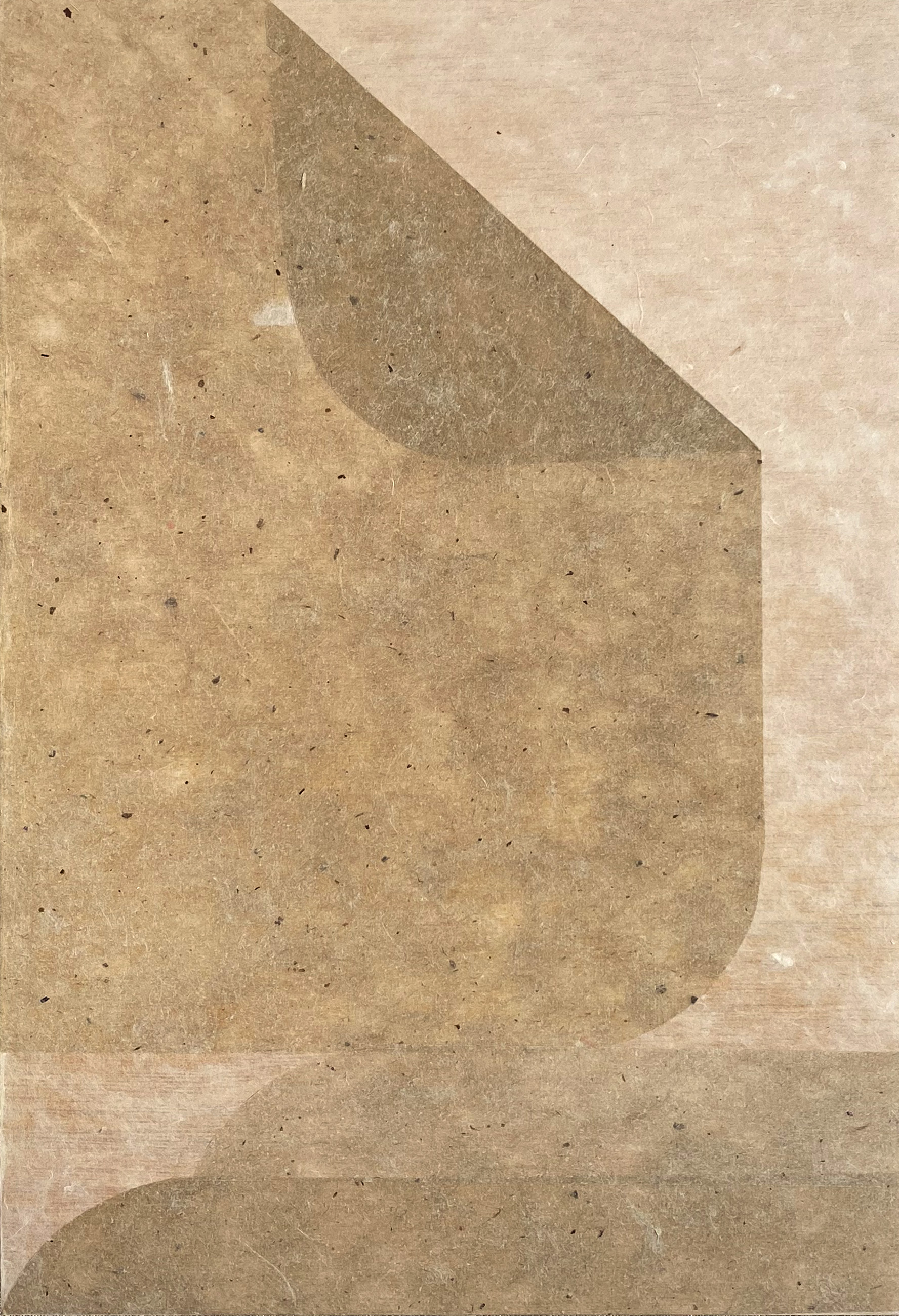
I’m also curious about how you feel living in Jerez — relatively “outside” the art circuit but still connected to it. Maybe that’s only possible today, in this interconnected world. How do you experience it?
I experience it through a kind of balance that I think reflects my personality quite well. On the one hand, I need peace and quiet to create. I’ve always understood the creative moment as something intimate, introspective. Even though I’ve shared studios and spaces, the essential part of the work I do alone, calmly. My nature leads me to seek that.
But at the same time, I need stimuli, to see what’s happening, to stay alert. I’m not at all interested in living isolated. That’s why I imagine a future project of a house-studio near the countryside, in a quiet place, but with the possibility of moving around when needed. To be able to travel once or twice a month to exhibitions, fairs, encounters. To have one foot in the local sphere, and another in the global one, so to speak.
And yes, that’s something that might’ve been difficult in another era. But today, thanks to the internet and the possibility of connecting with people and spaces from anywhere, it’s become more accessible. You can be in Jerez, working in your studio, and at the same time be part of the conversation happening in Madrid, Berlin, or Mexico City.
Lastly... is there any dream or project you’d like to develop soon?
Yes, there’s something I’ve been thinking about a lot lately: I would love to create a stage design. It’s an idea that excites me more and more. I think it could be a really interesting space for experimentation.
Of course, I understand that there would be a technical side to it, as well as spatial or material limitations. It wouldn’t be the same as working in my studio with complete freedom. But sometimes those limits help you focus, to concretize. Sometimes it's good to have boundaries — otherwise, you risk spreading yourself too thin.
But yes, it’s definitely something I’d like to explore.
Interview by Whataboutvic. 21.07.2025
